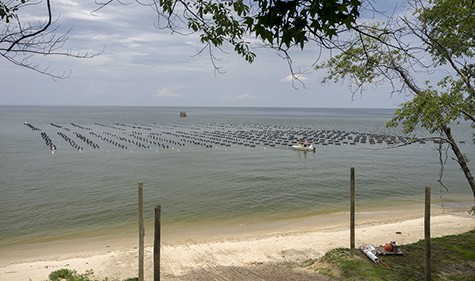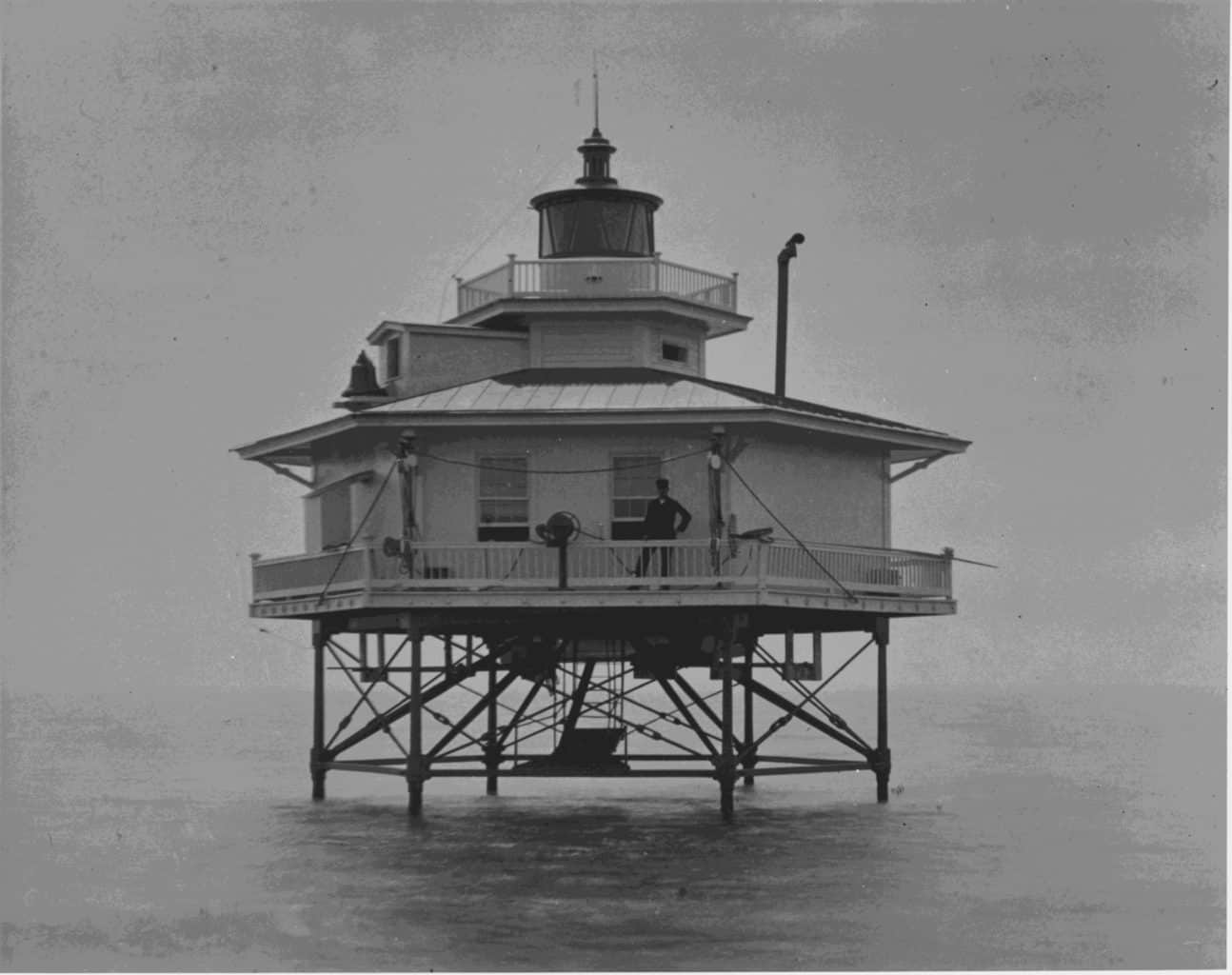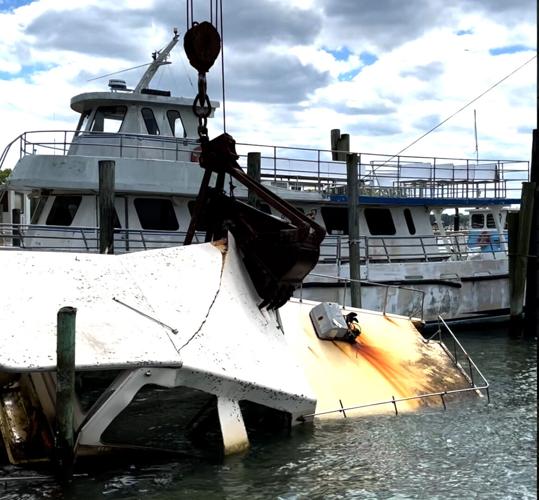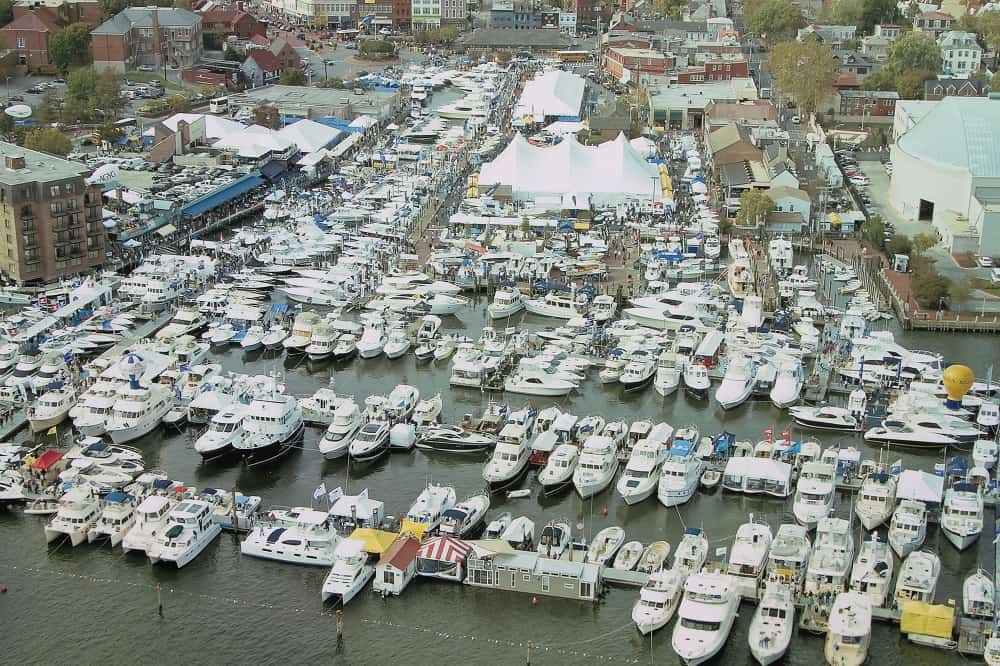By Timothy B. Wheeler, Bay Journal News Service
Oyster farming has grown rapidly in Maryland in recent years — too rapidly, in the eyes of some. Last week, spurred by complaints from waterfront homeowners and others, local elected officials in St. Mary’s County moved to put the brakes on the burgeoning industry along their shoreline.
The Southern Maryland county’s board of commissioners voted on July 31 to hold a public hearing on Aug. 28 on a proposed 18-month moratorium on the use of commercial docks to land oysters from any newly issued aquaculture leases in local waters.
JD Blackwell leases this site in St. Mary’s County, Md. Blackwell said that most of his oysters are raised in cages resting on the bottom, unseen at the water’s surface but for markers to identify the submerged equipment for boaters. Photo: Dave HarpRandy Guy, president of the five-member board of commissioners, said they want to “slow down” what he called a proliferation of oyster farming operations in St. Mary’s. The county has no direct role in the approval of state-issued aquaculture leases, so they’re looking to change that by asserting local zoning control over the use of docks and marinas that support the shellfish enterprises.
“We’ve got people coming in who are not involved in the local water culture,” Guy said, noting that some of those seeking leases don’t live in St. Mary’s. “We feel some of this is restricting recreational areas and causing hazards for boating. … I’m worried about an accident happening.”
He and other commissioners — three of whom own waterfront homes — have said they’re also concerned about the aesthetics and impacts on property values from cages or floating baskets of oysters in front of waterfront homes. And at least a couple contend homeowners should have a say in whether they’re permitted.
“Nobody’s against aquaculture. We support it,” said Todd Morgan, another commissioner, who acknowledged that he’d recently been notified of an application to lease 4.2 acres of the Patuxent River for oyster aquaculture just offshore from his home. “We just feel the property owner has a certain amount of rights in this state, too, and the law currently ignores riparian rights.”
The county’s vote came a day before the state Department of Natural Resources convened a workgroup to review Maryland’s 9-year-old aquaculture program. One of its chief goals is to find ways to reduce conflicts over leasing public waters for private use.
Oyster farmers and supporters say the proposed restriction on new aquaculture leases threatens to stifle an industry that’s both economically and ecologically beneficial.
“There’s a fight that’s among us …and it all comes down to one question,” said JD Blackwell, owner of 38° North Oysters, an aquaculture company he launched in St. Mary’s in 2013. “Is the right of a few property owners to preserve the view they want to have more important than the environmental good that is done by oyster aquaculture for all the citizens of the state of Maryland?”
Oyster farming has been going on in Maryland for a century or more, but it nearly died out about 15 years ago through a combination of restrictive laws and oyster diseases. The industry has rebounded, though, since the state liberalized its leasing laws nine years ago and offered some financial assistance to startups.
According to the DNR, private oyster production has soared from 3,340 bushels in 2012 to 74,066 bushels last year. The wild harvest, meanwhile, has declined in recent years, dropping to 180,000 bushels last season from 224,609 bushels the year before.
All told, Maryland has issued 424 leases in 11 counties to cultivate oysters in nearly 6,900 acres of the Chesapeake Bay and its tributaries, according to DNR data. Dorchester County has the highest number of leases; St. Mary’s is a close second, with 97 leases, or about 23 percent of the total.
“Oysters grow really well in St. Mary’s County,” noted Karl Roscher, DNR’s aquaculture director. He told the county commissioners earlier this year that about one-third of all the farm-raised oysters in Maryland came from their county, and that the operations employed 190 people.
Aquaculture’s rebound has not come easily, oyster farmers point out. They’ve had to contend with bureaucratic red tape and lengthy delays in getting state and federal approvals. Traditional watermen, some of whom also practice aquaculture, have objected to some leases that they contend would interfere with crabbing and fishing, while complaints from waterfront property owners have tied up lease applications for years. Only about half of the applications DNR has received since 2010 have been approved. Once permitted, aquaculturists still must deal not only with challenging natural conditions for raising oysters, but persistent poaching.
Tal Petty, another St. Mary’s County oyster farmer who’s fought his own battles with landowners and the legislature to get a lease in the Patuxent River offshore of historic Sotterley Plantation, said he’s very frustrated by the moratorium move.
“We’re raising sustainable shellfish. We’re doing everything the [state] policy asked us to do, and we’re still playing whack-a-mole and fighting flank attacks.”
There are 136 lease applications pending statewide, with 20 under protest, according to DNR figures. As of last month, according to a DNR listing given to the Maryland Aquaculture Coordinating Council, St. Mary’s has 44 pending applications, with eight under protest.
Four out of five leases issued by the state are for raising oysters loose on the bottom, much as they grow in the wild. The St. Mary’s commissioners said they aren’t bothered by those “submerged land leases,” because the bivalves are generally out of sight beneath the water. Rather, county officials are chiefly concerned with “water-column” leases, which permit oysters to be raised in cages on or just off the bottom, or in floating cages or trays on the surface. Those are one-fourth of all leases in the county, and industry experts say they represent modern aquaculture, which focuses on raising premium oysters for raw bars and restaurants.
“They’re really good operations,” said Don Webster, an extension agent with the Maryland Sea Grant program who helps promote aquaculture. “We want to see the industry continue to grow as it has.”
Thirteen waterfront homeowners sent a letter to the president of the St. Mary’s commissioners, expressing concern that the industry’s rapid expansion will “result in the conversion of our sleepy shoreline and marine areas into industrial uses incompatible with the expectations of recreational users of our waters and with surrounding residential areas.” They also argue that harvested oysters could be landed at facilities lacking proper refrigeration or sanitation, posing a public health risk. The letter urges county officials to impose a “cooling off” period to study imposing zoning restrictions to address their concerns.
County commissioner Morgan, a defense contractor, acknowledged that he’s personally affected by the issue, because there’s a lease pending by his home. He and his wife paid $1.26 million in 2004 for their 5-acre property on the Patuxent River, according to state records. But Morgan noted he’s not alone — Tom Jarboe and Michael Hewitt, two other commissioners also have waterfront homes, and they have voiced concerns about the state’s failure to notify local governments earlier about pending leases and the lack of control waterfront property owners have over leasing. Last week, Jarboe pointed out that waterfront homeowners pay thousands of dollars annually in property taxes, compared with the $25 per acre annual fees paid by lease holders.
JD Blackwell of 38° North Oysters, examines oyster spat at his nursery on the Potomac River in St. Mary’s County, MD. He says the proposed moratorium could affect his five-year-old company. “Is the right of a few property owners to preserve the view they want to have,” he asks, “more important than the environmental good that is done by oyster aquaculture for all the citizens of the state of Maryland?” (Dave Harp)
“If they’re going to be putting an industrial complex behind someone’s house,” Jarboe said, “it affects their property value, and they shouldn’t be paying the same taxes they’ve been paying, if that’s what we’re going to do.”
Guy, a farmer, said he personally enjoys eating farmed oysters — his brother raises some at his dock, he noted. But he added, “I’ve got to represent all the people, and I’m getting heat from waterfront landowners.”
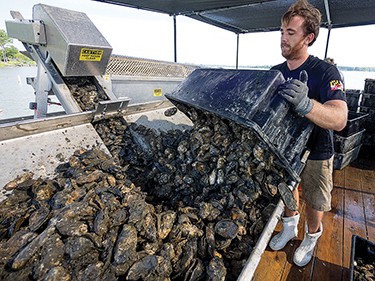
Aquaculturists dispute the characterization of their oyster farms as industrial operations. While oyster cages or floats require tending, it’s not done round-the-clock, they point out. And the boats they use are often smaller than those used by commercial watermen for crabbing. As for safety concerns, they point out that all farmed oysters are subject to rigorous state and federal food-safety requirements and inspections, regardless of where they are landed.
“My hope is that once these folks are made aware of the existing regulation, that their concerns will be alleviated,” said Patrick Hudson, owner of True Chesapeake Oyster Company in St. Jerome’s Creek. “There’s really no need to get the county involved in something that the state already has covered in the interests of the public.” But Hudson added that he suspects those concerns mask the homeowners’ real objections to the intrusion on their view of the water.
Roscher, the DNR aquaculture director, said his staff attempts to resolve any concerns raised, often asking applicants to modify or even move their leases. The review is painstaking and time-consuming, even in cases where there’s no opposition.
“We have a 2-acre water-column lease, and it took us three years to get it,” said Brian Russell, co-owner of Shore Thing Shellfish, which raises oysters in St. George’s Creek off the Potomac River. “It’s not like you just apply to the state, and they say sure, just go ahead.”
Russell said he doesn’t blame waterfront property owners for not wanting an oyster farm off their shore. “If I have a dock [or] pier and someone comes and puts a lease that’s 7 or 8 acres in front of my property, I think I’d be upset, too,” he said.
But others say waterfront homeowners’ objections shouldn’t be allowed to stop the industry’s growth.
“It’s such a positive activity ecologically and economically,” said Allison Colden, fisheries scientist with the Chesapeake Bay Foundation. Oysters filter polluting nutrients and sediment out of the water, and even caged shellfish attract other fish and crabs, providing some of the same habitat benefits that wild oyster reefs do.
“There’s already a process in place to address these types of conflicts with landowners and others,” Colden said. “It just seems an extreme reaction.”
Under state regulations, leases must be at least 50 feet from shore – a buffer that Guy and Morgan contend is much too small. But aquaculturists say that their leases are often moved farther out in the water to avoid Bay grasses or other potential conflicts, and are required to leave channels for boats to get to and from private docks on shore.
State regulations allow for waterfront property owners and others to ask for a public information meeting on a lease, and those who are personally affected may file a formal protest. By law, the DNR may not deny a lease solely because a landowner objects. But many applications languish for months or even years as state officials and aquaculturists try to resolve such disputes.
On Wednesday, both Guy and Morgan attended the initial meeting in Annapolis of the DNR workgroup tasked with reviewing the state’s aquaculture laws. DNR officials outlined plans to create an online registry of lease applications by fall. The county officials welcomed that, but pressed for landowners and local authorities to be notified as soon as a lease application comes in, so they can voice concerns earlier in the review process.
“But they do not own that water,” countered Moochie Gilmer, a clammer on the workgroup.
While traditional watermen have little sympathy with waterfront homeowners wanting to dictate what goes on beyond the shoreline, they have other concerns about oyster farming. During the 2.5-hour session, watermen complained that some leases have been granted in places where they once harvested wild oysters and that productive public clamming grounds have been lost because the law doesn’t exempt them from being leased.
Oyster farmers and their supporters said they’re worried that the DNR workgroup may focus more on restricting aquaculture than on freeing it of regulatory red tape and delays. One-third of the panel’s members are watermen and two of them have bottom leases. But aquaculturists say the DNR didn’t include anyone who’s growing bivalves in cages or floats — the activity that’s generating the most controversy.
Webster, the Sea Grant agent, pointed out that aquaculture has run up against similar pushback throughout the East Coast.
“Can a county stop water-column leases? I doubt it,” he said. “The state has the right to do a leasing program. We’re not New England — a local jurisdiction doesn’t get veto power. Do they have the right to prevent landings in a county? That’s an interesting question.” Years ago, he noted, Worcester County, home to Maryland’s Atlantic Ocean beach resort, prohibited the use of public docks for commercial fish landings.
It’s not clear yet what impact the proposed St. Mary’s restrictions would have.
The proposed ordinance would apply to “commercial docks” on land with “commercial marine” zoning. Blackwell said it could put a crimp in his aquaculture operations, because he has about 20 acres’ worth of leases pending, and two of the docks he uses are on land zoned for commercial marine activities.
Bill Hunt, head of land use and growth management for the county, said his staff will be working to identify all of the sites that fit those criteria.
The St. Mary’s commissioners stressed that they’ve not made up their minds on the moratorium and want to hear from all sides at the hearing, which is scheduled for 6:30 p.m. Aug. 28 at the Chesapeake Building, 41770 Baldridge Street in Leonardtown. But they said they hoped that their decision to hold the hearing might prompt the DNR to consider tweaking its leasing regulations.
Webster, the Sea Grant extension agent, said he’s worried that the St. Mary’s proposal might encourage other localities to try to restrict the industry within their borders.
“I hope it doesn’t send a message to other county commissioners,” he said.

